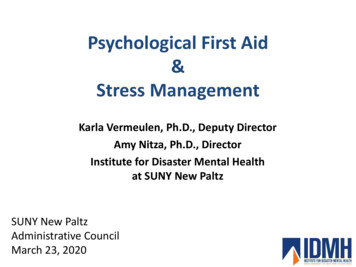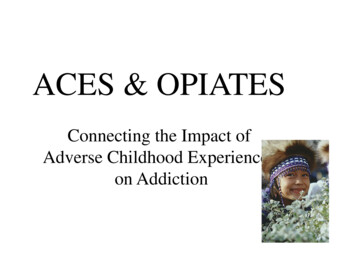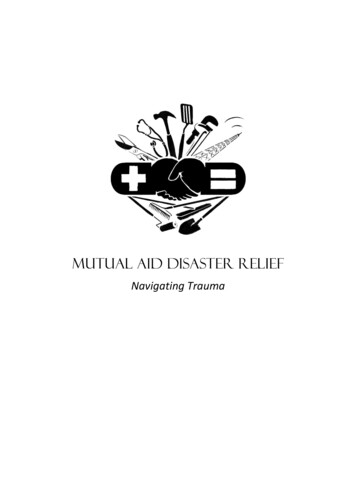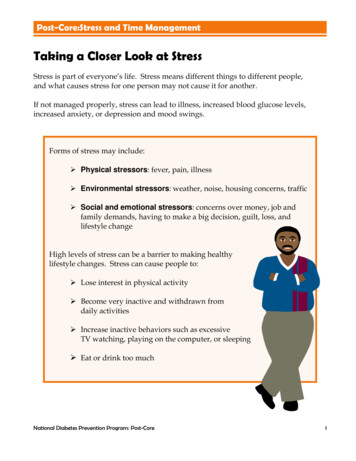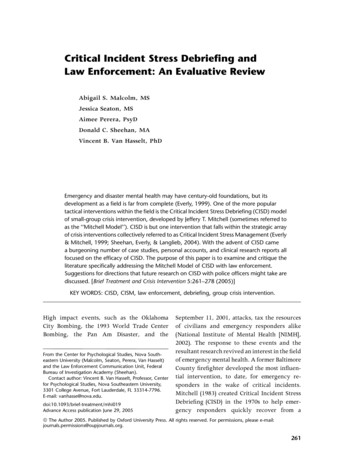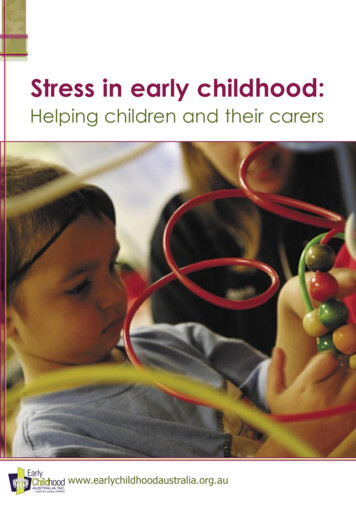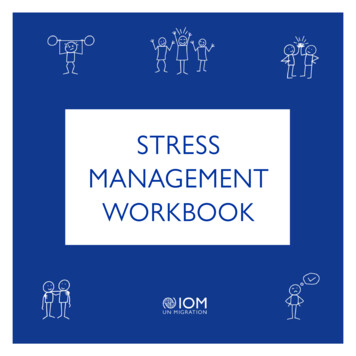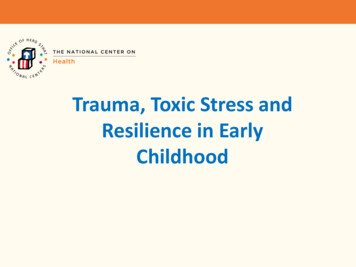
Transcription
Trauma, Toxic Stress andResilience in EarlyChildhood
Learning ObjectivesParticipants will be able to:PART 1:1.Define trauma2.Describe the potential impact of adverse experiences (toxicstress) on young children3.Identify signs and symptoms of trauma in infants, toddlersand preschoolers4.Identify steps to support children and families who haveexperienced trauma.
Learning ObjectivesParticipants will be able to:PART 2:1.Define resilience2.Identify strategies to build protective factors for youngchildren and their families
What is Trauma?
Trauma occurs when frightening events orsituations overwhelm a child'sability to cope or deal with whathas happened
Group Discussion:What kinds of potentially traumatic experiences dochildren and families face?
Toxic Stress
The Impact of Adverse Experiences:Years LaterLessons from the Adverse ChildhoodExperiences (ACES)
Adverse Childhood Experience(ACE) Outcomes
Knowing the Signs & Symptoms
Signs and Symptoms of Trauma inInfants and Toddlers Eating & Sleepingdisturbance Reacting toreminders/trauma triggers Clingy/separation anxiety Difficulty engaging in socialinteractions throughgestures, smiling, cooing Irritable/difficult to soothe Repetitive/post-traumaticplay Developmental regression Persistent self-soothingbehaviors, for example, headbanging Language delay Aggression (toddlers) General fearfulness/newfears, Easily startled
Signs and Symptoms of Trauma inPreschoolers Avoidant, anxious, clingy Sadness General fearfulness/newfears Repetitive/ posttraumatic play Helplessness, passive Talking about thetraumatic event andreacting to traumatriggers Restless, impulsive,hyperactive Physical symptoms(headache, etc.) Inattention, difficultyproblem solving Irritability Aggressive and/ orsexualized behavior Developmentalregression Poor peer relationshipsand social problems(controlling/overpermissive)
The OperationBreakthrough Experience:Part IHow trauma impacts children, families, and staffin a Head Start/Early Head Start setting
OPERATION BREAKTHROUGHfounded in 1971 by two sisters
Alice Berry GrahamCHILDREN’S MERCY HOSPITALfounded in 1897 by two sisters
Operation Breakthrough Missouri’s largest free standing early HeadStart program More than 400 children per day 92 % in poverty 96 % female headed household 20-25% are homeless Employees 100 people
Children’s Mercy Hospital Only children’s tertiary caresystem in region 354 beds, two hospitals,five urgent care sites Level I trauma center 40 peds sub-specialties Employees 6500 people Clinic at OB 15 years
Head Start and Pediatric HealthcareCommon Goals Optimize well being and potential of childrenand families Optimize readiness to develop and learn Address toxic stress; ameliorate adversechildhood experiences; respond to trauma Develop resilience
CMH-OB Partnership Children living in poverty have unique health andlearning challenges. Parents and children with multiple ACEs are on coursefor school failure, negative physical and mental healthoutcomes including early death. We want to change the trajectory for these children andfamilies. We believe interprofessional teams can knock downsilos and bring the best of healthcare and the best ofearly childhood education together to benefit thesechildren.
One Stop Shop - Supporting Families20 Interprofessional Team Clothes closet Head Start school Mental Health services Healthcare Family Advocate Dental Care Employment support OT and PT Adult education support Nutritious meals Early/Late child care Food Pantry Parenting support
Operation Breakthrough Parents, 2013Adverse Childhood ExperiencesACE CATEGORYPercent of ParentsNational Reference*Emotional Abuse2911Sexual Abuse2321Physical Abuse2328Emotional Neglect3815Physical Neglect1910Domestic violence1913Substance Abuse3227Mental Illness2319Parental divorce/separation4523Incarcerated family member22533.012.5Total ACEs 4 or more
Relationship of parental ACE score to their child’scurrent or past child adversity , 20135045% of children withadversity type403530Homelessness25Neglect20Separated from parent151050ACE 0ACE 1ACE 2ACE 3ACE 4ACE 5
Relationship of parental ACE score to their child’scurrent or past child adversity, 20136050% of children withadversity type40Live with drug abus30Live with IPVLive w/com. Violence20100ACE 0ACE 1ACE 2ACE 3ACE 4ACE 5
Group Discussion:Facilitated Referral Process What is your role in encouraging families toseek mental health services? How do you encourage families to seek helpafter potentially traumatic experiences? How can you help a referral for mental healthservices to be successful?
Head Start Performance Standards:Mental Health1304.24 (a) (1) Work Collaboratively with Parents1304.24 (a) (2) Must Secure the Services of Mental Health Professionals toenable the timely and effective identification and intervention in family andstaff concerns about a child’s mental health1304.24 (a) (3) must include a regular schedule of on-site mental healthconsultation
Summary Adverse experiences can impact very youngchildren Obtaining mental health services for children andfamilies who have experienced potentiallytraumatic experiences can help reduce thenegative impact of these experiences
Summary Understanding signs of trauma helps make surechildren who need help receive it Help for children who experience traumaincludes help for the caregivers and families whocare for them.
Part II:Supporting Resilience inEarly Childhood
Learning ObjectivesPART 2:Participants will be able to:1.Define resilience2.Identify strategies to support and promote protectivefactors in young children
What Protects Young Childrenfrom Adversity?Small group discussion with report out
Resilience Defined Recovering from or adjusting to misfortune or change The ability to bounce back Overcoming the odds
Resilience Model
Watch the Still Face Cliphttp://www.youtube.com/watch?v apzXGEbZht0.
The Most Important Vital SignTwo Generation Model Mother-baby relationship Other family relationships Family challenges/ACES Family resources/strengths
Trauma, Brain and Relationships:Helping Children Heal
The OperationBreakthrough Experience:Part IIAn example of putting these principles intopractice in a Head Start/Early Head Start setting
Calm DownBreatheCount 1, 2, 3, 4Breathing Star
A Place to Calm Down Physical space withineach classroom Safe place to calmdown Adults/teachers arepresent to helpchildrenlearn ways to selfsoothe.
Calm Down Toys
More Calm Down Toys
Self-Regulation Activities Musical activities (drumming, loud/soft)Stop-Start gamesHokey PokeyHead, Shoulders, Knees and ToesRepetitive songs (calm to excited then back tocalm) Physical activity (hop like frogs)
Take Care of YourselfOne-third of Americans areliving with extreme stress andnearly half of Americans(48%) believe that their stresshas increased over the pastfive years.Report from the American PsychologicalAssociation, 2012
Adults Under Chronic Stress Are often more irritable Are more likely to be inconsistent Have less energy Lose a feeling of joy of life
Take Care of Yourself: Tipswww.ecmhc.org
How Do You Build ProtectiveFactors in Young Children?Large Group Conversation With children? With families?
Provide Consistent, Responsive Caregiving Identify a primary caregiver to increase the level ofsupport and encouragement Hold, cuddle and rock children Respond gently & quickly to cues (smiles, cries, etc.) Talk to children about their emotions Stay close by as children interact with one another Observe each child’s skills
Provide Predictable Routines &A Safe Environment Maintain a predictable schedule Provide choices Provide a safe place for the child to talk or justrelax Be sensitive to cues the child gives related to theenvironment- create a soft, nurturing space
Core Strengths for ChildrenDeveloped by Bruce Perryhttp://www.childtrauma.org/ Attachment Self Regulation Affiliation Awareness Tolerance Respect
Supporting Families with Immediate NeedsKnow your community supports for: Housing, Food, & Clothing Job Training Transportation Health Care and Insurance Child Care subsidy What else?
Building Resilience “Ordinary Magic” Allows children to emergefrom stressful experienceswith unique strengths Allows healthydevelopment in spite ofadversity Adverse experiences arehistory, not destinyMastin, A. (2001) Ordinary Magic: Resilience Processes in Development.American Psychologist, 56 (3), 227-238
The Opportunity to . Identify toxic stress as a root cause of diseaseand learning difficulty in childhood Demonstrate early intervention can changethe trajectory toward positive health andschool success Lead change from an illness-based system to awellness-based system belongs to us!!!
Together we can accomplish so much
Wrap-Up Evaluation/Feedback What questions do you still have? What will you do differently? What will you remember?
Learn More . . . www.developingchild.harvard.edu – Many resources ontoxic stress & child development; Working papers aregreat synopsis of current science www.cdc.gov/ACE - Information on the ACE studies AAP’s Medical Home for Children Exposed to Violence(Google this phrase) www.NCTSN.org – Evidence-based evaluations of traumatreatment programs
National Center on HealthContact InformationToll-Free: 888-227-5125Email: v/hslc/ttasystem/health/center
Adverse Childhood Experiences ACE CATEGORY Percent of Parents National Reference* Emotional Abuse 29 11 Sexual Abuse 23 21 Physical Abuse 23 28 Emotional Neglect 38 15 Physical Neglect 19 10 Domestic violence 19 13 Substance Abuse 32 27 Mental Illness 23 19 Parental divorce/separation 45 23 Incarcerated family member 22 5



